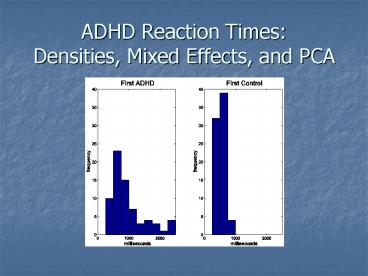ADHD Reaction Times: Densities, Mixed Effects, and PCA - PowerPoint PPT Presentation
Title: ADHD Reaction Times: Densities, Mixed Effects, and PCA
1
ADHD Reaction TimesDensities, Mixed Effects,
and PCA
2
ADHD Attention Deficit (Hyperactive) Disorder
- ADHD kids have difficulty in focusing on tasks.
- But true ADHD is rarer than is generally
believed, and drug treatments are used much too
often. - How can we correctly identify ADHD children?
3
Reaction Time Experiment
- 17 ADHD children
- 16 age-matched controls
- Warning of cue appears on computer screen.
- Delay of about 10 seconds.
- Cue actually appears.
- Measure the time it takes to react to the cue.
- Repeat and get about 70 reaction times for each
child. - Longer reaction times for ADHD than for controls.
But what do they look like? How to quantify?
4
How do reaction times differ between ADHD and
controls?
- ADHD child has many reaction times beyond 1 sec.
Not so for control. - How can we represent histogram as a smooth
density? - What are differences in shape, mean, mode, etc.,
between groups? - How can we account for child-to-child differences
when comparing the groups?
5
How can we represent the histogram as a smooth
curve?
- Simple answer Find the probability density
function using standard methods. - Problem with that Standard textbook densities
dont capture characteristics like - Initial lag
- Extreme peak immediately after lag
- Long right tail with many outliers
- New answer Use flexible modeling of density
functions to create a functional data object
6
How can we create a functional density object
from a histogram?
- Use tools from before
- Basis expansion linear combination of splines
- Roughness Penalty making explicit the competing
goals - Basis expansion with
- 34 B-splines of order 5
- Equally spaced knots
- Competing goals are
- Fitting density curve exactly to histogram
- Wanting curve to be close to a normal density
7
What about the constraints of a probability
density function?
- Constraints
- P(t) gt 0 over interval of interest.
- Area under the curve is 1.
- New tool Transformation.
- For any function W(t), can build a density
function - p(t) C expW(t), for C appropriate function
of W. - Transforms estimation problem from constrained
p(t) to unconstrained W(t)!
8
Hey, the original data arent really functional,
are they?
- Idea again Transformation.
- The functional object is really indirectly
related to the data. - Data reaction times t nonfunctional
- What we want reaction time densities p(t)
functional - Related through
9
What do the group densities look like?
- Definite shift in mode between groups.
- Bimodality, or even trimodality?
- ADHD has large shoulder and long tail.
- But what about individual differences in children?
10
Are there inter-child differences?
- Examples of four ADHD children
- Dashed line is group density for ADHD.
- Solid line is individual density for child.
- Definite child-to-child variability. Shouldnt
ignore this.
11
How can we estimate the densities and account for
individual differences?
Functional Mixed Effects Linear Model
- Transform first
- Subtract 120 from each reaction time
- Initial dead period not helpful
- Logarithm
- Effects are likely multiplicative, not additive
- Z log10(t-120)
12
What is our functional mixed effects model?
- Build mixed effects model
- Child i trial j group k
- Zijk transformed reaction time density
(functional) - µk typical performance of all children in group
k (functional) - aik individual performance of child i within
group k (functional) - Uijk leftover variation in density (functional)
Zijk µk a ik Uijk ? aik 0
13
- ADHD have greater variability in residuals.
- ADHD have greater mean residuals (952 vs 645
msec). - Modality an artifact of instruments.
14
How can we explore variability across subjects
within a group?
Functional Principal Components Analysis
- Goal
- explore how densities change from child to child.
- Idea
- Principal components (harmonics) are like
empirical basis functions. Want to expand our
densities with these harmonics. - Problem
- Hard to ensure that the densities are positive.
- Solution
- Transformation! Explore the derivatives instead.
15
What do the harmonics look like?
- Used weighted fPCA
- minimizes importance of variation when density is
small. - Back-transformed
- to get harmonics in original density scale.
- Harmonic Interpretations
- 1st More weight on central peak.
- 2nd More weight on early reaction times.
- 3rd Highlights periodic effect from
instrumentation.
16
What have we learned?
- Transformations
- The functional object can be indirectly related
to the data, such as the probability density
function - Functional Linear Model
- Can add random effects
- Functional Principal Components Analysis
- Can be done on a transformation, such as the log
density derivative

